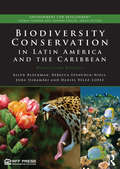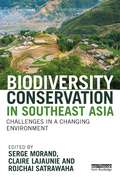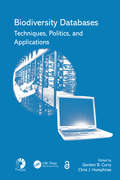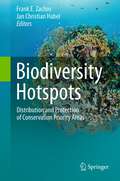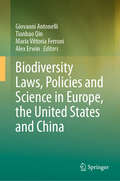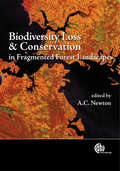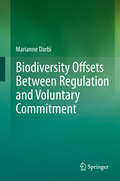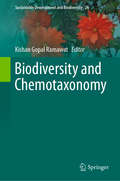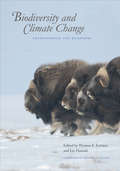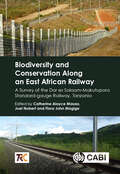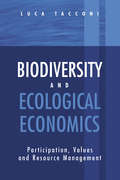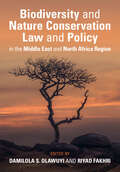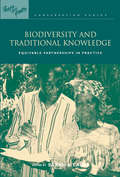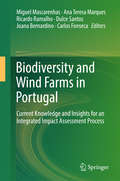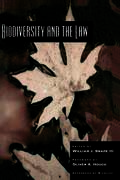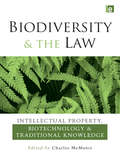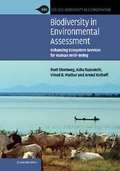- Table View
- List View
Biodiversity Conservation in Latin America and the Caribbean: Prioritizing Policies (Environment for Development)
by Allen Blackman Rebecca Epanchin-Niell Juha Siikamäki Daniel Velez-LopezLatin America and the Caribbean (LAC) region is exceptionally biodiverse. It contains about half of the world’s remaining tropical forests, nearly one-fifth of its coastal habitats, and some of its most productive agricultural and marine areas. But agriculture, fishing and other human activities linked to rapid population and economic growth increasingly threaten that biodiversity. Moreover, poverty, weak regulatory capacity, and limited political will hamper conservation. Given this dilemma, it is critically important to design conservation strategies on the basis of the best available information about both biodiversity and the track records of the various policies that have been used to protect it. This rigorously researched book has three key aims. It describes the status of biodiversity in LAC, the main threats to this biodiversity, and the drivers of these threats. It identifies the main policies being used to conserve biodiversity and assesses their effectiveness and potential for further implementation. It proposes five specific lines of practical action for conserving LAC biodiversity, based on: green agriculture; strengthening terrestrial protected areas and co-management; improving environmental governance; strengthening coastal and marine resource management; and improving biodiversity data and policy evaluation.
Biodiversity Conservation in Southeast Asia: Challenges in a Changing Environment (Earthscan Conservation and Development)
by Serge Morand, Claire Lajaunie and Rojchai SatrawahaSoutheast Asia is highly diversified in terms of socio-ecosystems and biodiversity, but is undergoing dramatic environmental and social changes. These changes characterize the recent period and can be illustrated by the effects of the Green Revolution in the late 1960s and 1970s, to the globalization of trade and increasing agronomic intensification over the past decade. Biodiversity Conservation in Southeast Asia provides theoretical overviews and challenges for applied research in living resource management, conservation ecology, health ecology and conservation planning in Southeast Asia. Five key themes are addressed: origin and evolution of Southeast Asian biodiversity; challenges in conservation biology; ecosystem services and biodiversity; managing biodiversity and living resources; policy, economics and governance of biodiversity. Detailed case studies are included from Thailand and the Lower Mekong Basin, while other chapters address cross-cutting themes applicable to the whole Southeast Asia region. This is a valuable resource for academics and students in the areas of ecology, conservation, environmental policy and management, Southeast Asian studies and sustainable development.
Biodiversity Databases: Techniques, Politics, and Applications
by Gordon B. CurryWith changes in technology and a renewed effort to catalog the world's biodiversity, huge amounts of data are being generated on biodiversity issues. As response to the call for better information systems to manage the biodiversity crisis, a wide range of solutions are being developed for inventorying, managing, and disseminating taxonomic data. This book brings together a diverse array of authors, expertise, and assessors that discuss technical developments to improve the construction, population, and dissemination of biodiversity information. It is designed to inform students and researchers of biodiversity about the changes and challenges that need to be understood by everyone in this information age.
Biodiversity Hotspots: Distribution and Protection of Conservation Priority Areas
by Jan Christian Habel Frank E. ZachosBiodiversity and its conservation are among the main global topics in science and politics and perhaps the major challenge for the present and coming generations. This book written by international experts from different disciplines comprises general chapters on diversity and its measurement, human impacts on biodiversity hotspots on a global scale, human diversity itself and various geographic regions exhibiting high levels of diversity. The areas covered range from genetics and taxonomy to evolutionary biology, biogeography and the social sciences. In addition to the classic hotspots in the tropics, the book also highlights various other ecosystems harbouring unique species communities including coral reefs and the Southern Ocean. The approach taken considers, but is not limited to, the original hotspot definition sensu stricto and presents a chapter introducing the 35th hotspot, the forests of East Australia. While, due to a bias in data availability, the majority of contributions on particular taxa deal with vertebrates and plants, some also deal with the less-studied invertebrates. This book will be essential reading for anyone involved with biodiversity, particularly researchers and practitioners in the fields of conservation biology, ecology and evolution.
Biodiversity Islands: Strategies for Conservation in Human-Dominated Environments (Topics in Biodiversity and Conservation #20)
by Florencia MontagniniThis book is intended to provide an overview for the identification and establishment of biodiversity islands. It presents examples and case studies where the biodiversity islands approach is being used in a variety of locations and contexts worldwide. It will contribute to design parameters on appropriate sizing and spatial distribution of biodiversity islands in order to be effective in conservation and regeneration across the landscape, using integrated landscape management approaches. This book is essential given the current worldwide trend of habitat destruction and the need to preserve biodiversity and its values. The chapters are organized in five sections. The first section provides the introduction. Section 2,3 and 4 discuss the challenges and alternatives of establishment and management, case studies across the globe, safeguarding of the environmental, economic, and social benefits, and the final section offers a conclusion. The contributing authors present views from the academic, the practitioner and the policymaker perspectives, offering alternatives and suggestions for promoting strategies that support biodiversity conservation through intentionally designed frameworks for sustainable forest landscapes. Readers will discover suggestions and concrete examples that can be used by a variety of stakeholders in various settings throughout the world. This book is useful to researchers, farmers, foresters, landowners, land managers, city planners, and policy makers alike.
Biodiversity Laws, Policies and Science in Europe, the United States and China
by Tianbao Qin Maria Vittoria Ferroni Giovanni Antonelli Alex ErwinThis book offers an in-depth analysis of and multidisciplinary insights into the latest trends in biodiversity laws, policies and science in Europe, the United States, and China. The loss of biodiversity and degradation of ecosystems continues at an alarming rate, harming people, the economy, and the climate. As biodiversity cannot be meaningfully addressed by any single field, a multidisciplinary approach is needed to attain a better understanding of its complexity and to identify prevention and protection systems. Each chapter addresses a specific aspect of biodiversity. Taken together, they provide an innovative exploration of the various facets of biodiversity from the perspectives of law, the social sciences and natural sciences. As such, the book offers an essential theoretical and practical guide for academics, experts, policymakers, and students alike.
Biodiversity Loss and Conservation in Fragmented Forest Landscapes: Evidence from Tropical Montane and South Temperate Rain Forests in Latin America
by A. C. NewtonThe studies reported allow for comparative analysis across areas and help identify how human disturbance has impacted the biodiversity of all forest types. Chapters incorporate features of landscape ecology, floristic biodiversity, conservation and policy and vary from in-depth investigations of a single study area to integrated examinations across regions.
Biodiversity Offsets Between Regulation and Voluntary Commitment: A Typology of Approaches Towards Environmental Compensation and No Net Loss of Biodiversity
by Marianne DarbiWe are witnessing an alarming, global biodiversity crisis with an ongoing loss of species and their habitats. In response, a number of tools and approaches – including some that are contested – are being explored and promoted. Biodiversity offsets are one such approach, and deserve critical examination since the debate surrounding them has often been oversimplified and lacking practical evidence. As such, this study presents a refined typology including seven types of biodiversity offsets and taking into account different contexts, governance arrangements and drivers. It draws on a detailed analysis of theoretical concepts to explain the voluntary implementation of biodiversity offsets using an internet-based (netnographic) research approach. Furthermore it builds on a broad global explorative base of 72 practical examples and presents in-depth case studies for each type. The results reveal a number of global tendencies that allow recommendations to be made for different locations, contexts and stakeholders. They also encourage the expansion of this research field to respond to the pressing needs of policy and practice.
Biodiversity Offsets: The European Perspective On No Net Loss Of Biodiversity And Ecosystem Services
by Wolfgang Wende Fabien Quétier Matt Rayment Marianne Darbi Graham TuckerThis book deals with the new concept of biodiversity offsets. The aim of offsetting schemes is to achieve no let loss or even net gain of biodiversity. Offsets obey a mitigation hierarchy and reflect the precautionary and polluter-pays principle in regard to project impacts. Readers gain insights into current debates on biodiversity policies, with top experts outlining theoretical principles and the latest research findings. At the same time the focus is on practical application and case studies. Today there is a lively international discussion among practitioners and scientists on the optimal legal framework, metrics and design of habitat banks to ensure the success of biodiversity offsets and to minimise the risks of failure or misuse. Contributing to the debate, this volume presents the activities and practices of biodiversity offsetting already implemented in Europe in selected EU member states, and the lessons that can be learnt from them. Readers may be surprised at how much experience already exists in these countries. A further aim of the book is to offer grounded insights on the road ahead, and foster a more intensive and fruitful discussion on how offsetting can be extended and improved upon, so that it becomes a key and effective component of Europe’s biodiversity conservation policy framework.
Biodiversity and Business: Bio Prospecting and Benefit Sharing
by Oommen V. Oommen Prakash Nelliyat Laladhas Krishna PanickerThis book addresses the climate risk influencing biodiversity globally and discusses the sustainable use of biological diversity and its legal implications. The sustainable bio-prospecting will help conservation regarding the resources and livelihood support of those who conserve it from the UN CBD perspective. In mega bio-diverse countries, biodiversity provides a number of ecosystem services as well as sources of income/livelihood for millions of poor and they are also the home of a vast repository of traditional knowledge (TK) associated with biological resources which can be translated therapeutically. As for Climate risks, the risks related to unscientific management and use of biodiversity are far more compared to the benefits for society and business and therefore, reducing pressure on biodiversity and developing a sustainable commodity supply chain is essential for both the industry and the governments. Exploring and further mining of the vastness of biodiversity potential, in the marketplace, has been a subject of great consideration among biotechnologists, food processors, health care specialists and the like, as they are real money-spinners. The book will be of interest to researchers/College/ University students interested in ecology and biodiversity conservation worldwide
Biodiversity and Chemotaxonomy (Sustainable Development and Biodiversity #24)
by Kishan Gopal RamawatPlant classifications are based on morphological characters and it is difficult, particularly in small plants and grasses, to identify these below generic level on the basis of these characters using a dissecting microscope. Plant species have intra- and inter-specific variation in secondary metabolites which can be utilized as marker compounds for identification and classification of plants. Secondary metabolites are produced as a result of primary metabolism and the production of these compounds not only involves several genes but also it is an energy dependent process. Hence these products cannot be considered as insignificant for the plant and the environment. Modern tools of molecular biology and secondary metabolites present in them can definitively decide about classification of plants. Absence of correct identification of plant is associated to many problems of resource utilization. Due to wide availability of these tools, interest has revived in systematics and correct classification of plants based on these parameters for their sustainable utilization and resource management. The purpose of this book is to assess the potential of phytochemical and molecular tools in the systematic and classification of plants. The topics covered include species concept, barcoding and phylogenetic analysis, chemotaxonomy use of polyketides, carotenes, cuticular wax, volatile oils, biodiversity of corals, metazoans, Ruta and Echinocereus. It provides comprehensive and broad subject-based reviews, useful for students, teachers, researchers, and all others interested in the field. The field has been kept wide and general to accommodate the wide-ranging topics. This book will be useful to agriculturists, chemists, botanists, industrialists, and those involved in planning of crop plants.
Biodiversity and Climate Change: Transforming the Biosphere
by Edward O. Wilson Thomas E. Lovejoy Lee HannahAn essential, up-to-date look at the critical interactions between biological diversity and climate change that will serve as an immediate call to action The physical and biological impacts of climate change are dramatic and broad‑ranging. People who care about the planet and manage natural resources urgently need a synthesis of our rapidly growing understanding of these issues. In this all‑new sequel to the 2005 volume Climate Change and Biodiversity, leading experts in the field summarize observed changes, assess what the future holds, and offer suggested responses. From extinction risk to ocean acidification, from the future of the Amazon to changes in ecosystem services, and from geoengineering to the power of ecosystem restoration, this book captures the sweep of climate change transformation of the biosphere.
Biodiversity and Conservation Along an East African Railway: A Survey of the Dar es Salaam-Makutupora Standard-gauge Railway, Tanzania
by N A Mbwambo Edmond Alavaisha S. Zainabu Bungwa Philbert Anitha Byabato Deusdedith Fidelis Elikana John Jasson John Julius Mohamed Kibaja Heriel Moshy Athumani Fatina Mturi R. Juma Mwangi Henry Ndangalasi Wilrik Ngalasoni Alberto Bruno Nyundo Chacha Werema Felix A. ShayoIt is well known that infrastructure development projects can boost the economy and reduce the cost of trade in both developing and developed economies, however, infrastructure projects can also cause biodiversity loss. This book is the result of an important biodiversity survey conducted along an East African railway in Tanzania. The building of the railway, still under construction, has already led to habitat loss, habitat degradation and landscape change which may have affected biodiversity. The book includes recommendations to mitigate the effect of railway construction by protecting biodiversity and ecosystem services which could have major implications across Africa and other regions. The area covered by the survey focuses on the Standard Gauge Railway (SGR) running through the Pugu and Ruvu South Forest Reserves towards Maktupora-Dodoma, plus data on large mammals through to Isaka-Shinyanga. The Pugu forests boast high biodiversity of both flora and fauna, some of which are endemic to the area. There are both plant and animal species that are of major conservation concern so there is urgent need to consolidate information to help formulate suitable conservation measures. The data collected covers plants, invertebrates, amphibians, birds, and mammals for terrestrial and aquatic environments along the SGR. This work is timely as there are many more ongoing SGR construction projects in Tanzania and across Africa, as such construction activities inevitably involve some habitat modification and destruction that may have a negative impact on biodiversity. National and international scientists, decision and policy makers, as well as ecologists and conservation managers involved in large infrastructure projects will find this book invaluable. The book provides baseline information and can be used as a case study for other infrastructure development projects around the world.
Biodiversity and Conservation of Woody Plants (Sustainable Development and Biodiversity #17)
by M. R. Ahuja S. Mohan JainThis book provides complete, comprehensive, and broad subject-based reviews for students, teachers, researchers, policymakers, conservationists, and NGOs interested in the biodiversity and conservation of woody plants. Forests cover approximately 31 percent of the world's total landmass; 93 percent is natural forest and only 7 percent consists of planted trees. Forest decline is progressing at an alarming rate worldwide. In addition to human activities (logging, deforestation, and exploiting forest lands for agriculture and industrial use), a number of other factors - including pests and diseases, drought, soil acidity, radiation, and ozone - are cumulatively contributing to global forest decline. The present situation forces us to focus on forest conservation strategies for the present and future. Gene conservation and maintaining genetic diversity in forest ecosystems are crucial to the preservation of forest genetic resources. This calls for integrated action to implement both the in situ (on site) preservation of forest stands and ex situ (distant from the original site) strategies for the conservation of woody plants' genetic resources. Selected priority areas include: 1) assessing patterns of genetic diversity and threats, 2) understanding the biological processes regulating genetic diversity, 3) assessing the impact of human activities and climate change on genetic diversity, and 5) finding methods for prioritizing species and populations for the conservation of forest trees genetic resources. All chapters were written by leading scientists in their respective fields, which include: woody plant diversity, ecology and evolution; assessment of genetic diversity in forest tree populations; conservation planning under climate change; and in situ and ex situ strategies, including biotechnological approaches, for the conservation of woody plants genetic resources.
Biodiversity and Conservation of the Yucatán Peninsula
by Gerald Alexander Islebe Sophie Calmé Jorge L. León-Cortés Birgit SchmookThis book provides information relevant for the conservation of biodiversity and the sound management of the coastal and forest ecosystems of the Yucatan Peninsula in the face of global change. Various aspects of the biodiversity of the Yucatan Peninsula are analyzed in an integrative manner, including phenological, ecophysiological, ecological and conservation aspects of plants and animals and their relationships with humans in coastal and forest ecosystems.
Biodiversity and Ecological Economics: Participatory Approaches to Resource Management
by Luca TacconiIt is vital that we adopt interdisciplinary approaches such as ecological economics to gain an understanding of the values that determine human interaction with, and use and abuse of, the environment. This book is a model of applied ecological economics. It presents an accessible introduction to the subject while at the same time broadening its theoretical basis by introducing a post-positivist, participatory method. The theoretical framework is applied to case studies in biodiversity conservation, drawn from around the world and a range of different ecosystems. The book is a suitable textbook for students of ecological economics and an ideal introduction for scientists and environmentalists needing to understand the role of economics in ecology and conservation.
Biodiversity and Health in the Face of Climate Change
by Aletta Bonn Horst Korn Jutta Stadler Melissa R. Marselle Katherine N. IrvineThis open access book identifies and discusses biodiversity’s contribution to physical, mental and spiritual health and wellbeing. Furthermore, the book identifies the implications of this relationship for nature conservation, public health, landscape architecture and urban planning – and considers the opportunities of nature-based solutions for climate change adaptation. This transdisciplinary book will attract a wide audience interested in biodiversity, ecology, resource management, public health, psychology, urban planning, and landscape architecture. The emphasis is on multiple human health benefits from biodiversity - in particular with respect to the increasing challenge of climate change. This makes the book unique to other books that focus either on biodiversity and physical health or natural environments and mental wellbeing. The book is written as a definitive ‘go-to’ book for those who are new to the field of biodiversity and health.
Biodiversity and Nature Conservation Law and Policy in the Middle East and North Africa Region
by Damilola S. Olawuyi Riyad FakhriThis book offers a comprehensive and authoritative account of the guiding principles and rules relating to biodiversity, nature conservation, and the protection of cultural heritage in the MENA region. The book introduces readers to the applicable legislation, institutions and rules underpinning the design, approval, financing and implementation of biodiversity and nature-based solutions across the MENA region. It also explores larger questions on legal and institutional frameworks that can help address broader issues of fragmentation, gender inequality, inadequate stakeholder engagement, lack of transparency, limited access to environmental information, and lack of comprehensive domestic legislation, all of which stifle the integrated implementation of biodiversity and nature conservation treaties and the equitable sharing of the benefits derived from biodiversity and nature in the region. Written in a user-friendly style, the book closes with recommendations and reflections on legal and regulatory innovations for advancing biodiversity and nature-based solutions in the MENA region. This title is also available as open access on Cambridge Core.
Biodiversity and Pest Management in Agroecosystems
by Miguel Altieri Clara NichollsExplore the latest research on biological control! Completely updated for 2004, this new edition examines methods for making agricultural systems less susceptible to insect pests. Containing new findings and reports of strategies, Biodiversity and Pest Management in Agroecosystems, Second Edition will show you how pests can be managed by enhancing beneficial biodiversity using agroecological diversification methods. Biodiversity and Pest Management in Agroecosystems, Second Edition provides you with an essential overview of the role of biodiversity in agriculture and then gets specific, with new and updated information on: the agroecology of pest management plant diversity and pest outbreaks within agroecosystems diversification strategies for pest management how sustainable farming systems are designed You'll also explore: the role of plant diversity on the biology of beneficial insects insect regulation in diverse agroecosystems manipulation of plant diversity in agroecosystems ecological and socioeconomic implications The fact is, many modern agroecosystems are unstable as a consequence of constant human intervention in crop systems which ignore ecological principles. With case studies on a variety of crops and pests, Biodiversity and Pest Management in Agroecosystems, Second Edition explores entomological aspects of agriculture and analyzes the ecological basis for the maintenance of biodiversity. It will familiarize you with the theory and practice of enhancing biological pest control in agricultural systems by managing vegetational diversity via multiple cropping, cover cropping, rotations, and other spatial and temporal designs. With studies on intercropping, cover cropping, weed management, and crop-field border vegetation manipulation, this book covers the effects of these diverse systems on pest population density and the mechanisms underlying pest reduction in polycultures. Make it a part of your reference/teaching collection today!
Biodiversity and Traditional Knowledge: Equitable Partnerships in Practice (People And Plants International Conservation Ser.)
by Sarah A. LairdBiodiversity research and prospecting are long-standing activities taking place in a new legal and ethical environment. Following entry into force of the Convention on Biological Diversity in 1993, and other recent policy developments, expectations and obligations for research and prospecting partnerships have changed. However, to date there are few guides to integrating these concepts with practice. This book offers practical guidance on how to arrive at equitable biodiversity research and prospecting partnerships. Drawing on experience and lessons learned from around the world, it provides case studies, analysis and recommendations in a range of areas that together form a new framework for creating equity in these partnerships. They include researcher codes of ethics, institutional policies, community research agreements, the design of more effective commercial partnerships and biodiversity prospecting contracts, the drafting and implementation of national 'access and benefit-sharing' laws, and institutional tools for the distribution of financial benefits. As part of the People and Plants initiative to enhance the role of communities in efforts to conserve biodiversity and use natural resources sustainably, Biodiversity and Traditional Knowledge will be invaluable to students, researchers and local communities, academic institutions, international agencies, government bodies and companies involved in biodiversity research, prospecting and conservation.
Biodiversity and Wind Farms in Portugal: Current knowledge and insights for an integrated impact assessment process
by Miguel Mascarenhas Ana Teresa Marques Ricardo Ramalho Dulce Santos Joana Bernardino Carlos FonsecaThis book presents a review of the state-of-the-art knowledge on the interactions between biodiversity and wind energy development, focused on the Portuguese reality. The volume addresses the particularities of the impact assessment procedures in Portugal, contrasting it with the international practices and presenting its main findings by covering the following broader themes: i) evaluation of spatial and temporal dynamics of wildlife affected by wind farms, including birds, bats and terrestrial mammals (in particularly Portuguese wolf population); ii) the methodologies used to assess impacts caused by this type of developments in biodiversity; iii) the best practice methodologies to implement an adaptive management approach to reconcile biodiversity and wind farms. The knowledge presented in this book was gathered through the research and development activities developed by Bioinsight company (former Bio3 company) during the last 13 years and partially funded by a R&D project designated as "Integrated solutions for biodiversity management at wind farms: reduce and compensate bird and bat mortality" (acronym: Wind & Biodiversity), co-funded by the European Regional Development Fund (FEDER), under the Regional Operational Programme of Centre (Mais Centro). This volume fills a void in the literature as a book giving insights on the best practices to install and manage a wind farm from a biodiversity management point of view, while establishing a commitment between economic sustainability and biodiversity conservation.
Biodiversity and the Law
by Mollie Beattie Scott Hajost John Pendergrass Jason Patlis Leesteffy Jenkins Dinah BearBiodiversity and the Law is a timely and provocative volume that combines historical perspective and cutting-edge legal analysis in an authoritative and broad discussion of biodiversity and the law. Leading legal and policy experts consider a variety of options for the worldwide protection of biodiversity and present a succinct but comprehensive overview of the legal mechanisms available. They examine how conservation advocates can better utilize existing law, and consider what new law is needed.Among the topics considered are: scientific and policy foundations of biodiveristy protection domestic efforts to establish an effective endangered species protection regime international biodiversity protection biodiversity as a genuinely public entity the future of biodiversity law Contributors include Mollie Beattie, Don Waller, Jason Patlis, Lindell Marsh, Todd Olson, Peter Jenkins, Suzanne Iudicello, John Pendergrass, Dinah Bear, Walter Kuhlmann, Rodger Schlickeisen, David Downes, and others.
Biodiversity and the Law: "Intellectual Property, Biotechnology and Traditional Knowledge"
by Charles R. McManisHow do we promote global economic development, while simultaneously preserving local biological and cultural diversity? This authoritative volume, written by leading legal experts and biological and social scientists from around the world, aims to address this question in all of its complexity. The first part of the book focuses on biodiversity and examines what we are losing, why and what is to be done. The second part addresses biotechnology and looks at whether it is part of the solution or part of the problem, or perhaps both. The third section examines traditional knowledge, explains what it is and how, if at all, it should be protected. The fourth and final part looks at ethnobotany and bioprospecting and offers practical lessons from the vast and diverse experiences of the contributors.
Biodiversity and the Precautionary Principle: Risk, Uncertainty and Practice in Conservation and Sustainable Use
by Barney Dickson Rosie CooneyGreat uncertainty typically surrounds decisions and management actions in the conservation of biodiversity and natural resource management, and yet there are risks of serious and irreversible harm for both biodiversity and the humans that rely on it. The precautionary principle arguably underlies all international conservation efforts and promotes acting to avoid serious or irreversible environmental harm, despite lack of scientific certainty as to the likelihood, magnitude or cause of harm. This book is the first to examine the application of the precautionary principle to biodiversity conservation and natural resource management, incorporating perspectives from scientists, economists, lawyers and practitioners from both developing and developed countries. It analyses the application and impacts of the principle in many areas including forestry, invasive alien species, wildlife trade, protected areas and fisheries, in a range of national and international contexts. Particular attention is drawn to issues of equity, livelihoods, science and politics, and the book provides guidelines for applying the precautionary principle to biodiversity conservation and natural resource management.
Biodiversity in Environmental Assessment
by Roel Slootweg Asha Rajvanshi Vinod B. Mathur Arend KolhoffHuman induced development activities are introduced with insufficient attention to their consequences for our living environment, even in cases where environmental assessments have been carried out. This apparent lack of attention to biodiversity in environmental assessment is rooted in the difficulties we have in adequately addressing biodiversity within the scope, time frame and budget allocated for assessments. This book provides a conceptual background and practical approaches to overcome these difficulties. It integrates the objectives of the Convention on Biological Diversity, its ecosystem approach, and the conceptual framework of the Millennium Ecosystem Assessment into a comprehensive approach to biodiversity in environmental assessment. It highlights the need to consider the value of biodiversity based on its use by each stakeholder, addresses the importance of both social and economic development to reach the Millennium Development Goals, and provides insights into ways to balance present and future needs.
